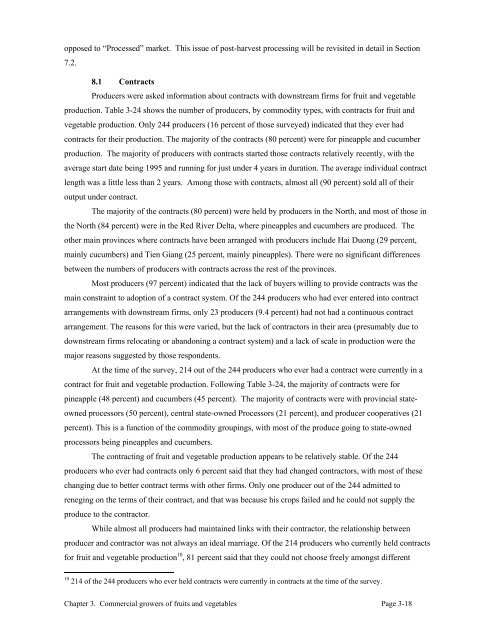Fruits and Vegetables in Vietnam - International Food Policy ...
Fruits and Vegetables in Vietnam - International Food Policy ...
Fruits and Vegetables in Vietnam - International Food Policy ...
Create successful ePaper yourself
Turn your PDF publications into a flip-book with our unique Google optimized e-Paper software.
opposed to “Processed” market. This issue of post-harvest process<strong>in</strong>g will be revisited <strong>in</strong> detail <strong>in</strong> Section<br />
7.2.<br />
8.1 Contracts<br />
Producers were asked <strong>in</strong>formation about contracts with downstream firms for fruit <strong>and</strong> vegetable<br />
production. Table 3-24 shows the number of producers, by commodity types, with contracts for fruit <strong>and</strong><br />
vegetable production. Only 244 producers (16 percent of those surveyed) <strong>in</strong>dicated that they ever had<br />
contracts for their production. The majority of the contracts (80 percent) were for p<strong>in</strong>eapple <strong>and</strong> cucumber<br />
production. The majority of producers with contracts started those contracts relatively recently, with the<br />
average start date be<strong>in</strong>g 1995 <strong>and</strong> runn<strong>in</strong>g for just under 4 years <strong>in</strong> duration. The average <strong>in</strong>dividual contract<br />
length was a little less than 2 years. Among those with contracts, almost all (90 percent) sold all of their<br />
output under contract.<br />
The majority of the contracts (80 percent) were held by producers <strong>in</strong> the North, <strong>and</strong> most of those <strong>in</strong><br />
the North (84 percent) were <strong>in</strong> the Red River Delta, where p<strong>in</strong>eapples <strong>and</strong> cucumbers are produced. The<br />
other ma<strong>in</strong> prov<strong>in</strong>ces where contracts have been arranged with producers <strong>in</strong>clude Hai Duong (29 percent,<br />
ma<strong>in</strong>ly cucumbers) <strong>and</strong> Tien Giang (25 percent, ma<strong>in</strong>ly p<strong>in</strong>eapples). There were no significant differences<br />
between the numbers of producers with contracts across the rest of the prov<strong>in</strong>ces.<br />
Most producers (97 percent) <strong>in</strong>dicated that the lack of buyers will<strong>in</strong>g to provide contracts was the<br />
ma<strong>in</strong> constra<strong>in</strong>t to adoption of a contract system. Of the 244 producers who had ever entered <strong>in</strong>to contract<br />
arrangements with downstream firms, only 23 producers (9.4 percent) had not had a cont<strong>in</strong>uous contract<br />
arrangement. The reasons for this were varied, but the lack of contractors <strong>in</strong> their area (presumably due to<br />
downstream firms relocat<strong>in</strong>g or ab<strong>and</strong>on<strong>in</strong>g a contract system) <strong>and</strong> a lack of scale <strong>in</strong> production were the<br />
major reasons suggested by those respondents.<br />
At the time of the survey, 214 out of the 244 producers who ever had a contract were currently <strong>in</strong> a<br />
contract for fruit <strong>and</strong> vegetable production. Follow<strong>in</strong>g Table 3-24, the majority of contracts were for<br />
p<strong>in</strong>eapple (48 percent) <strong>and</strong> cucumbers (45 percent). The majority of contracts were with prov<strong>in</strong>cial stateowned<br />
processors (50 percent), central state-owned Processors (21 percent), <strong>and</strong> producer cooperatives (21<br />
percent). This is a function of the commodity group<strong>in</strong>gs, with most of the produce go<strong>in</strong>g to state-owned<br />
processors be<strong>in</strong>g p<strong>in</strong>eapples <strong>and</strong> cucumbers.<br />
The contract<strong>in</strong>g of fruit <strong>and</strong> vegetable production appears to be relatively stable. Of the 244<br />
producers who ever had contracts only 6 percent said that they had changed contractors, with most of these<br />
chang<strong>in</strong>g due to better contract terms with other firms. Only one producer out of the 244 admitted to<br />
reneg<strong>in</strong>g on the terms of their contract, <strong>and</strong> that was because his crops failed <strong>and</strong> he could not supply the<br />
produce to the contractor.<br />
While almost all producers had ma<strong>in</strong>ta<strong>in</strong>ed l<strong>in</strong>ks with their contractor, the relationship between<br />
producer <strong>and</strong> contractor was not always an ideal marriage. Of the 214 producers who currently held contracts<br />
for fruit <strong>and</strong> vegetable production 10 , 81 percent said that they could not choose freely amongst different<br />
10 214 of the 244 producers who ever held contracts were currently <strong>in</strong> contracts at the time of the survey.<br />
Chapter 3. Commercial growers of fruits <strong>and</strong> vegetables Page 3-18
















